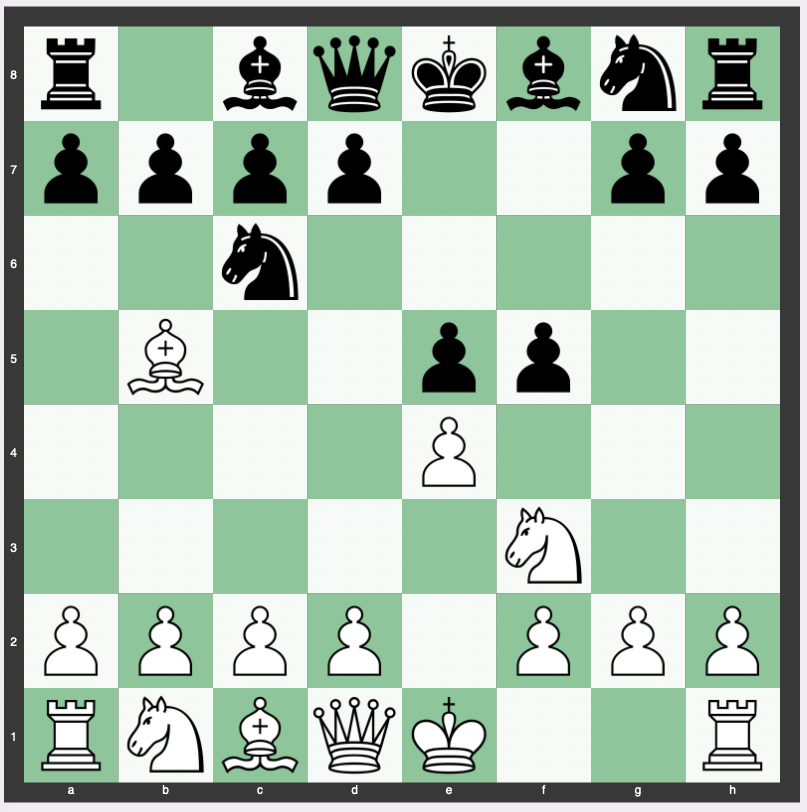The Schliemann Defense, also known as the Schliemann–Jaenisch Gambit, presents a fascinating and daring approach to the game of chess.
Aimed at a kingside attack, this sharp line within the Ruy Lopez offers players the opportunity to sacrifice pawns for the initiative.
Let’s explore the various aspects of this intriguing defense to understand its intricacies, history, and suitability for different levels of players.
Move Order of the Schliemann Defense
The Schliemann Defense is reached through the following moves: 1. e4 e5 2. Nf3 Nc6 3. Bb5 f5.

This move order sets the stage for an aggressive response by Black, who plays for a kingside attack.
Theory, Strategy and Purpose of the Schliemann Defense
The key idea behind the Schliemann Defense is to disrupt White’s central control and initiate a rapid kingside attack.
Black’s move 3…f5 signals the intention to challenge White’s pawn structure and control over the center.
The defense is considered to be positionally risky but a good practical weapon, especially for those willing to play aggressively.
Variations of the Schliemann Defense
The most common responses to 3…f5 by White are 4.d3 and 4.Nc3.
The line 4.Nc3 fxe4 5.Nxe4 can lead to great complications following 5…d5, or quieter play after 5…Nf6.
If 4.exf5, 4…e4 forces the knight to retreat, where 5…Qg5 prepares to regain the pawn and attack g2, while also preventing Qh5+.
Evaluation of the Schliemann Defense
The position has an evaluation of approximately +0.60 for white.
Continuation Lines in the Schliemann Defense
Sample continuation lines might include:
4. d3
4. d3 fxe4 5. dxe4 Nf6 6. O-O Bc5 7. Bxc6 bxc6 8. Nxe5 O-O 9. Nc3 d6 10. Nd3 Bd4 11. Qe1 Qe8 12. Be3 Bxc3 13. Qxc3 Qxe4 14. Rfe1 Bd7 15. f3 Qg6 16. Nf4 Qf5 17. Qc4+ Rf7 18. Rad1 Qb5
4. d3 fxe4 5. dxe4 Nf6 6. O-O Bc5 7. Bxc6 bxc6 8. Nxe5 O-O 9. Nc3 Ba6 10. Nd3 Bb6 11. Be3 Bxe3 12. fxe3 Qe7 13. Rf4 d5 14. Qf3 g5 15. Qg3 Nxe4 16. Rxf8+ Rxf8
4. Nc3
4. Nc3 fxe4 5. Nxe4 Nf6 6. Qe2 Qe7 7. O-O d5 8. Nxf6+ gxf6 9. d4 e4 10. Nh4 Bg7 11. c3 O-O 12. Qh5 Qf7 13. Qxf7+ Rxf7 14. Be2 Ne7 15. Bh5 Rf8 16. f3 c6 17. g3 Bh3 18. Ng2
4. Nc3 fxe4 5. Nxe4 Nf6 6. Qe2 d5 7. Nxf6+ gxf6 8. d4 Bg7 9. dxe5 O-O 10. O-O Nxe5 11. Qd1 Bg4 12. Be2 c6 13. Re1 Bxf3 14. Bxf3 f5 15. g3 Qf6 16. Bh5 Ng6 17. Bd2 f4 18. Bc3 Qf5 19. Bxg7 Kxg7
History of the Schliemann Defense
This variation was originated by Carl Jaenisch in 1847 and is sometimes named after him.
Though later attributed to German lawyer Adolf Karl Wilhelm Schliemann, the line he actually played in the 1860s was a different gambit variation of the Cordel Defence.
Is the Schliemann Defense Good for Beginners or Intermediates?
The Schliemann Defense can be an appealing choice for intermediate players looking to embrace an aggressive style of play.
However, it might be less suitable for beginners, as it is positionally risky and requires a good understanding of the ensuing complexities.
Exotic Trap in the Most Aggressive Gambit vs The Ruy Lopez
How Often Is the Schliemann Defense Played at the Grandmaster Level?
Teimour Radjabov is currently the only top player who regularly employs this line, with mixed results.
The defense has been occasionally used at the grandmaster level, but it is not considered to be a mainline response.
In the 1970s, Jozef Boey played the Schliemann Defense in the ICCF correspondence chess world championship final and even wrote a book about it.
Conclusion
The Schliemann Defense is an intriguing and bold choice in the Ruy Lopez. It invites complexity, offers opportunities for a spirited attack, and can lead to rich positions that reward creative play.
While appealing for aggressive intermediate players, beginners may find it daunting due to the positional risks involved.
Its occasional appearance at the grandmaster level further demonstrates the richness of the defense, albeit not being a mainstream choice.
Those willing to embrace its challenges might find the Schliemann Defense a rewarding and exciting path to explore in their chess journey.


